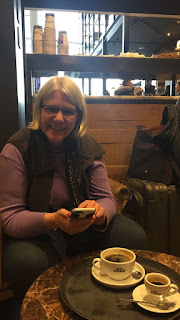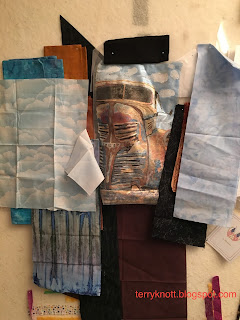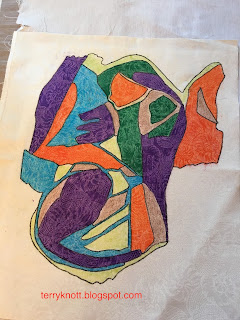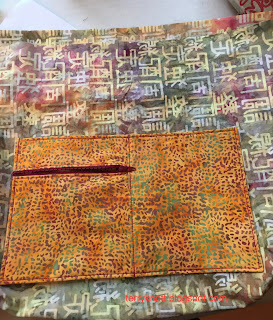 |
| Selvages crammed into a plastic bag |
As I've cut fabrics for projects, I've saved the selvages into a plastic bag. I filled the bag. I used more fabrics and saved more selvages. I crammed the selvages into the bag. When I couldn't cram any more in the bag, I laid them on top of the bag. I used more fabrics and saved even more selvages. These last selvages I threw in the general direction of the bag. Consequently, the floor became a storage vessel. . . .which is not good! The time to use some of these selvages had come!
 |
| Pattern and some of the fabrics |
I selected my pattern along with a piece of 70s calico, that I was gifted and that I intended to use as a foundation for piecing the strips. It took longer than I had envisioned, but, I did stitch the selvages into "fabric" for the main bag. The pattern used a random selection of 1 1/2 inch to 3 1/2 inch strips. Two separate panels were to be constructed.
 |
| Selvage fabric ready for quilting |
I decided that it would be easier to match the panel side seams if the front and back were cut from one piece of fabric so I stitched one panel and cut it into pieces. I used an overlapping technique of stitching the selvages. You can click here for a
tutorial by Avery Lane Sewing. My "muslin" square was 42" x 27"!
I liked the color effect of using the printed edge of the selvage in the grouping. Another time, I might try a different technique with the selvages, like glue basting them together and omitting stitching them to a foundation. Also, 42 inches can be unwieldy so I might try two 22 inch wide sandwiches next time. In the end, my muslin square wasn't quite wide enough. You'll need to keep reading as to when I discovered that as well as what I did to remedy the issue.
 |
| Webbing that created some challenges |
I could have layered my selvages onto the batting and backing and quilted as I went. I decided I would layer it all after I had finished. Yes, I would have an extra layer of cotton fabric in my bag; but, I decided that this would add more substance to the bag.
 |
| Sorted selvages |
When I finished stitching the fabric, I sorted the remaining selvages into a plastic bag that has lengths longer than 42", a plastic bag that contains selvages between 18" to 42" and a plastic bag that contains less than 18" lengths of selvages. I still have a lot of selvages! I hope that my updated storage system is more useable as I have several other projects noodling in my head that I would like to make. I do plan to stitch another project sooner rather than later so that I can deplete these plastic bags of their contents a bit and keep the storage system under better control!
I pulled out my 80/20 batting scraps and found that I had a chunk that was almost the right size; but, not quite. I pieced it. For bags, placemats and small projects, I will use pieced batting. Yes, it takes time and thread to stitch the pieces together. Yes, the batting gets a bit wonky. By the time it is quilted into the project, you wouldn't know that the batting is pieced. I'd rather spend my money on other supplies so I will take the time to piece together the leftover pieces of batting and have them ready for use.
 |
| Inside pockets on the bag back |
As I quilted, I found that my 39C foot produced the best results for stitching 1/8"-1/16" from the selvage edge. I tried a variety of free motion feet and the walking foot. Moving the needle slightly to the right achieved the close edge stitching. Since the foot had more contact with the selvage edge, it was faster and easier to quilt the strips. Sometimes, free motion quilting isn't the best alternative!
My end piece was about 20"x26" and it should have been 21"x26". I didn't think that the inch would matter much so I added the outer pocket and began working on the inner pockets. I'm glad that I had pinned the inner pockets in place because when I added the 2" webbing, I found several challenges. First, I chose that webbing because I liked the design and because I thought that two inches would feel better carrying the bag weight on my shoulder than the 1" that was listed on the pattern supply list.
 |
| Finished bag back |
I didn't have enough room for the inner pockets with the 2" webbing. I also realized that the additional outer pockets that I added to the bag back, would interfere with the usability of the inner pockets. I thought about what to do. I decided that I would remove the outer pockets from the bag back.
I decided to add 3 1/2" pieces to each side of the selvage fabric. Of course, I would need to add strips to the lining as well. In the end, this was a great solution. First, it made the bag a bit larger so my cutting mat slides in easily. Second, I no longer had to be concerned about matching the selvages at the side seams. Third, the strips added a nice decorative touch to the bag. Fourth, I used more of my stash!!
The lining fabric I bought more than fifteen years ago. When I tried to use it in projects, I either didn't have enough or the grey in the green fought with my other fabric choices. I have petted it often over the years. Now, I have about half a yard left! The rust red fabric that I used for the binding, pockets and side pieces were purchased when I visited our youngest daughter in Philadelphia about twelve years ago! Just a few strips remain of that fabric!
 |
| Finished bag front |
I bound the edges of the tote with binding which made for a nice finish. Joie, my Bernina 790, stitched through all the layers beautifully. She stitched through the thick portion of the bag bottom which contained the pockets and the webbing like she was stitching on two layers of cotton!
I love the finished tote and I have an outer pocket for another bag in the future. Another time, I might use a lighter stabilizer as this bag is fairly heavy empty! This is my ninth finish for the quarter and goal number 11 on my Finish-A-Long
list.
I used five yards of fabric from my stash which brings my "net loss" of fabric for the year to eight yards. (Only 42 yards to go to meet my goal of 50 yards for 2018!)








































